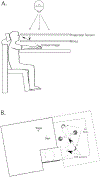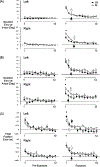Interlimb transfer of visuomotor rotations: independence of direction and final position information
- PMID: 12172655
- PMCID: PMC10704413
- DOI: 10.1007/s00221-002-1140-7
Interlimb transfer of visuomotor rotations: independence of direction and final position information
Abstract
Previous findings from our laboratory support the idea that the dominant arm is more proficient than the non-dominant arm in coordinating intersegmental dynamics for specifying trajectory direction and shape during multijoint reaching movements. We also showed that adaptation of right and left arms to novel visuomotor rotations was equivalent, suggesting that this process occurs upstream to processes that distinguish dominant and non-dominant arm performance. Because of this, we speculate that such visuomotor adaptations might transfer to subsequent performance during adaptation with the other arm. We now examine whether opposite arm training to novel visuomotor rotations transfers to affect adaptation using the right and left arms. Two subject groups, RL and LR, each comprising seven right-handed subjects, adapted to a 30 degrees counterclockwise rotation in the visual display during a center-out reaching task performed in eight directions. Each group first adapted using either the right (RL) or left (LR) arm, followed by opposite arm adaptation. In order to assess transfer, we compared the same side arm movements (either right or left) following opposite arm adaptation to those performed prior to opposite arm adaptation. Our findings indicate unambiguous transfer of learning across the arms. Different features of movement transferred in different directions: Opposite arm training improved the initial direction of right arm movements under the rotated visual condition, whereas opposite arm training improved the final position accuracy, but not the direction of left arm movements. These findings confirm that transfer of training was not due to a general cognitive strategy, since such an effect should influence either hand equally. These findings support the hypothesis that each arm controller has access to information learned during opposite arm training. We suggest that each controller uses this information differently, depending on its proficiency for specifying particular features of movement. We discuss evidence that these two aspects of control are differentially mediated by the right and left cerebral hemispheres.
Figures



Similar articles
-
Mechanisms underlying interlimb transfer of visuomotor rotations.Exp Brain Res. 2003 Apr;149(4):520-6. doi: 10.1007/s00221-003-1392-x. Epub 2003 Feb 26. Exp Brain Res. 2003. PMID: 12677333 Free PMC article.
-
Interlimb transfer of visuomotor rotations depends on handedness.Exp Brain Res. 2006 Nov;175(2):223-30. doi: 10.1007/s00221-006-0543-2. Epub 2006 May 30. Exp Brain Res. 2006. PMID: 16733695 Free PMC article.
-
Evidence for a dynamic-dominance hypothesis of handedness.Exp Brain Res. 2002 Jan;142(2):241-58. doi: 10.1007/s00221-001-0913-8. Epub 2001 Nov 22. Exp Brain Res. 2002. PMID: 11807578 Free PMC article.
-
Limitations in interlimb transfer of visuomotor rotations.Exp Brain Res. 2004 Mar;155(1):1-8. doi: 10.1007/s00221-003-1691-2. Epub 2003 Dec 19. Exp Brain Res. 2004. PMID: 15064878 Free PMC article.
-
The symmetry of interlimb transfer depends on workspace locations.Exp Brain Res. 2006 Apr;170(4):464-71. doi: 10.1007/s00221-005-0230-8. Epub 2005 Nov 23. Exp Brain Res. 2006. PMID: 16328262 Free PMC article.
Cited by
-
Mirror Visual Feedback Training Improves Intermanual Transfer in a Sport-Specific Task: A Comparison between Different Skill Levels.Neural Plast. 2016;2016:8628039. doi: 10.1155/2016/8628039. Epub 2016 Aug 24. Neural Plast. 2016. PMID: 27642526 Free PMC article.
-
Understanding mechanisms of generalization following locomotor adaptation.NPJ Sci Learn. 2024 Jul 23;9(1):48. doi: 10.1038/s41539-024-00258-2. NPJ Sci Learn. 2024. PMID: 39043679 Free PMC article.
-
Effects of intermanual transfer induced by repetitive precision grip on input-output properties of untrained contralateral limb muscles.Exp Brain Res. 2007 Oct;182(4):459-67. doi: 10.1007/s00221-007-1004-2. Epub 2007 Jun 12. Exp Brain Res. 2007. PMID: 17562034
-
Context-dependent partitioning of motor learning in bimanual movements.J Neurophysiol. 2010 Oct;104(4):2082-91. doi: 10.1152/jn.00299.2010. Epub 2010 Aug 4. J Neurophysiol. 2010. PMID: 20685927 Free PMC article. Clinical Trial.
-
Intermanual transfer of visuomotor adaptation is related to awareness.PLoS One. 2019 Sep 6;14(9):e0220748. doi: 10.1371/journal.pone.0220748. eCollection 2019. PLoS One. 2019. PMID: 31490953 Free PMC article.
References
-
- Amunts K, Schlaug G, Schleicher A, Steinmetz H, Dabringhaus A, Roland PE, Zilles K (1996) Asymmetry in the human motor cortex and handedness. Neuroimage 4:216–222 - PubMed
-
- Bizzi E (1987) Motor control mechanisms. An overview. Neurol Clinics 5:523–528 - PubMed
-
- Bizzi E, Abend W (1983) Posture control and trajectory formation in single- and multi-joint arm movements. Adv Neurol 39:31–45 - PubMed
-
- Bizzi E, Accornero N, Chapple W, Hogan N (1982) Arm trajectory formation in monkeys. Exp Brain Res 46:139–143 - PubMed
-
- Bizzi E, Polit A, Morasso P (1976) Mechanisms underlying achievement of final head position. J Neurophysiol 39:435–444 - PubMed
MeSH terms
Grants and funding
LinkOut - more resources
Full Text Sources

